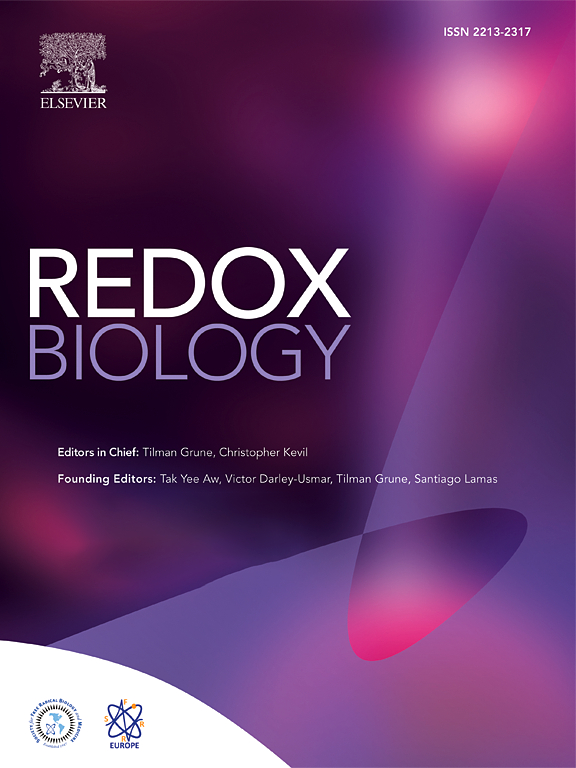Enhancing Gpx1 palmitoylation to inhibit angiogenesis by targeting PPT1
IF 10.7
1区 生物学
Q1 BIOCHEMISTRY & MOLECULAR BIOLOGY
引用次数: 0
Abstract
The significance of protein S-palmitoylation in angiogenesis has been largely overlooked, leaving various aspects unexplored. Recent identification of Gpx1 as a palmitoylated protein has generated interest in exploring its potential involvement in novel pathological mechanisms related to angiogenesis. In this study, we demonstrate that Gpx1 undergoes palmitoylation at cysteine-76 and -113, with PPT1 playing a crucial role in modulating the depalmitoylation of Gpx1. Furthermore, we find that PPT1-regulated depalmitoylation negatively impacts Gpx1 protein stability. Interestingly, inhibiting Gpx1 palmitoylation, either through expression of a non-palmitoylated Gpx1 mutant or by expressing PPT1, significantly enhances neovascular angiogenesis. Conversely, in PPT1-deficient mice, angiogenesis is notably attenuated compared to wild-type mice in an Oxygen-Induced Retinopathy (OIR) model, which mimics pathological angiogenesis. Physiologically, under hypoxic conditions, Gpx1 palmitoylation levels are drastically reduced, suggesting that increasing Gpx1 palmitoylation may have beneficial effects. Indeed, enhancing Gpx1 palmitoylation by inhibiting PPT1 with DC661 effectively suppresses retinal angiogenesis in the OIR disease model. Overall, our findings highlight the pivotal role of protein palmitoylation in angiogenesis and propose a novel mechanism whereby the PPT1-Gpx1 axis modulates angiogenesis, thereby providing a potential therapeutic strategy for targeting PPT1 to combat angiogenesis.
通过靶向 PPT1 增强 Gpx1 棕榈酰化抑制血管生成
蛋白质 S-棕榈酰化在血管生成中的重要性在很大程度上被忽视了,导致各方面的问题尚未得到探索。最近发现 Gpx1 是一种棕榈酰化蛋白,这引起了人们探索其可能参与血管生成相关新病理机制的兴趣。在这项研究中,我们证明了 Gpx1 在半胱氨酸-76 和-113 处发生棕榈酰化,而 PPT1 在调节 Gpx1 的去棕榈酰化过程中起着至关重要的作用。此外,我们还发现 PPT1 调控的去棕榈酰化对 Gpx1 蛋白的稳定性有负面影响。有趣的是,通过表达非棕榈酰化的 Gpx1 突变体或表达 PPT1 来抑制 Gpx1 的棕榈酰化,能显著增强新生血管的生成。相反,在模拟病理性血管生成的氧诱导视网膜病变(OIR)模型中,与野生型小鼠相比,PPT1 缺陷小鼠的血管生成明显减弱。生理学上,在缺氧条件下,Gpx1棕榈酰化水平会急剧下降,这表明增加Gpx1棕榈酰化可能会产生有益的影响。事实上,通过使用 DC661 抑制 PPT1 来增强 Gpx1 的棕榈酰化,能有效抑制 OIR 疾病模型中视网膜血管的生成。总之,我们的研究结果强调了蛋白质棕榈酰化在血管生成中的关键作用,并提出了 PPT1-Gpx1 轴调节血管生成的新机制,从而为靶向 PPT1 对抗血管生成提供了潜在的治疗策略。
本文章由计算机程序翻译,如有差异,请以英文原文为准。
求助全文
约1分钟内获得全文
求助全文
来源期刊

Redox Biology
BIOCHEMISTRY & MOLECULAR BIOLOGY-
CiteScore
19.90
自引率
3.50%
发文量
318
审稿时长
25 days
期刊介绍:
Redox Biology is the official journal of the Society for Redox Biology and Medicine and the Society for Free Radical Research-Europe. It is also affiliated with the International Society for Free Radical Research (SFRRI). This journal serves as a platform for publishing pioneering research, innovative methods, and comprehensive review articles in the field of redox biology, encompassing both health and disease.
Redox Biology welcomes various forms of contributions, including research articles (short or full communications), methods, mini-reviews, and commentaries. Through its diverse range of published content, Redox Biology aims to foster advancements and insights in the understanding of redox biology and its implications.
 求助内容:
求助内容: 应助结果提醒方式:
应助结果提醒方式:


